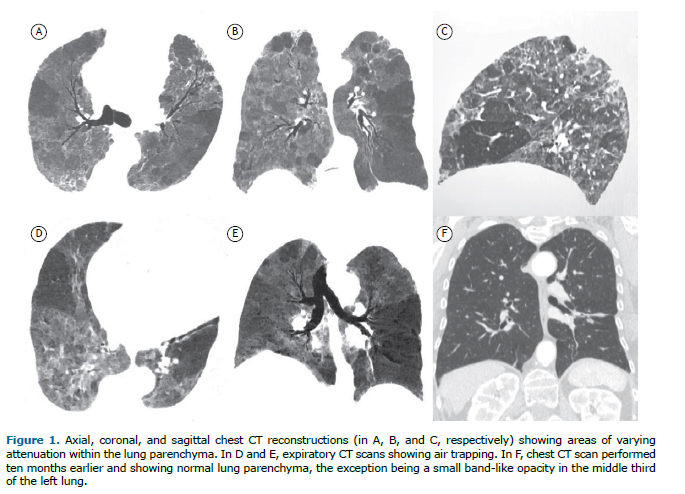An 80-year-old woman with no history of smoking, asthma, or other lung diseases presented to the emergency department with fever, nausea, and intense tiredness. She was diagnosed with COVID-19 by RT-PCR. Her SpO2 was 85% on room air. She continued to experience dyspnea on moderate and severe exertion two and a half months after discharge. Her cardiac evaluation was normal. A CT scan of the chest was requested, showing a pattern of mosaic attenuation (Figures 1A, 1B, and 1C). Expiratory CT scans showed air trapping (Figures 1D and 1E). A chest CT scan performed ten months earlier (in November of 2019) showed normal lung parenchyma (Figure 1F).

Mosaic attenuation is a CT pattern that is defined as heterogeneous areas of differing lung attenuation. It can be seen in patients with vascular disease, small airway disease, or parenchymal lung disease. In the case of our patient, CT findings of air trapping and normal pulmonary vasculature led to a diagnosis of small airway disease. Bronchiolitis, hypersensitivity pneumonitis, and bronchial asthma are some of the diseases of the small airways that are most commonly associated with mosaic attenuation. (1) Air trapping has been described in patients recovering from COVID-19, and histopathological studies have shown acute bronchiolitis and necrotizing bronchiolitis.(2)
REFERENCES1. Marchiori E, Hochhegger B, Zanetti G. Mosaic attenuation. J Bras Pneumol. 2019;45(6):e20190343. https://doi.org/10.1590/1806-3713/e20190343
2. Dai H, Zhang X, Xia J, Zhang T, Shang Y, Huang R, et al. High-resolution Chest CT Fea-tures and Clinical Characteristics of Patients Infected with COVID-19 in Jiangsu, China. Int J Infect Dis. 2020;95:106-112. https://doi.org/10.1016/j.ijid.2020.04.003




